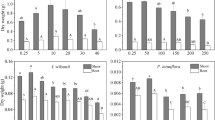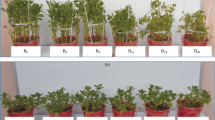Abstract
Salinity and high boron (B) concentrations are important co-limitations to crop production on naturally occurring alkaline soils in low rainfall regions of the world. Although the interactive effects of salinity and B toxicity on Brassica juncea growth have been reported in slightly acidic soils, very little is known about the interactive effects in alkaline soils. In the current study, a moderately tolerant (Vaibhav) and sensitive (Xinyou5) variety, were grown hydroponically for four weeks to assess mild salinity (50 mM NaCl) with or without high B (1 mM B) at moderate alkalinity (pH 8.5/5 mM NaHCO3). The growth of the two varieties was more affected under the combined treatment than either salinity or high B alone. Although growth rate reduction was similar among the varieties, Vaibhav maintained a lower sodium (Na) and B and a higher potassium (K) concentration in the leaves than Xinyou5. In response to salinity, Vaibhav demonstrated essential tolerance mechanisms of partial exclusion and presumably compartmentalization of Na, leading to greater biomass than Xinyou5. Despite being able to better exclude B, Xinyou5 suffered a greater growth penalty, indicating higher B sensitivity than Vaibhav. In conclusion, screening for individual stresses is not necessarily the best strategy because plant responses to a single stress either salinity or high B may not always be the same as observed when both stresses are present together. Therefore, Brassica germplasm screening is essential for stresses in combination but not separately.
Similar content being viewed by others
References
Alpaslan M. & Gunes A. 2001. Interactive effects of boron and salinity stress on the growth, membrane permeability and mineral composition of tomato and cucumber plants. Plant Soil 236: 123–128.
Amtmann A. & Sanders D. 1998. Mechanisms of Na+ uptake by plant cells. Advan. Bot. Res. 29: 75–112.
Ashraf M. 2001. Relationships between growth and gas exchange characteristics in some salt-tolerant amphidiploid Brassica species in relation to their diploid parents. Plant Sci. 160: 683–689.
Ashraf M. & McNeilly T. 2004. Salinity tolerance in Brassica oilseeds. Crit. Rev. Plant Sci. 23: 157–174.
Blumwald E., Grover A. & Good A.G. 2004. Breeding for abiotic stress resistance: Challenges and opportunities. Paper presented at the “New directions for a diverse planet”. Proceedings of the 4th International Crop Science Congress, 26 Sep–1 Oct 2004, Brisbane, Australia.
Burton W.A., Ripley V.L., Potts D.A. & Salisbury P.A. 2004. Assessment of genetic diversity in selected breeding lines and cultivars of canola quality Brassica juncea and their implications for canola breeding. Euphytica 136: 181–192.
Campbell T.A., Rathjen A.J., Paull J.G. & Islam A.K.M.R. 1998. Method for screening bread wheat for tolerance to boron. Euphytica 100: 131–135.
Dang Y., Routley R., McDonald M., Dalal R., Singh D., Orange D. & Mann M. 2006. Subsoil constraints in Vertosols: crop water use, nutrient concentration, and grain yields of bread wheat, durum wheat, barley, chickpea, and canola. Austral. J. Agric. Res. 57: 983–998.
Grievea C.M., Possa J.A., Grattanb S.R., Suareza D.L. & Smith T.E. 2010. The combined effects of salinity and excess boron on mineral ion relations in broccoli. Scientia Horticult. 125: 179–187.
Hayes J.E. & Reid R.J. 2004. Boron tolerance in barley is mediated by efflux of boron from the roots. Plant Physiol. 136: 3376–3382.
Javid M. 2012. Physiological and molecular mechanisms of tolerance to salinity, alkalinity and alkaline salinity in Brassica juncea. PhD thesis, Melbourne School of Land and Environment — Agriculture and Food Systems, The University of Melbourne.
Javid M., Ford R. & Nicolas M.E. 2012. Tolerance responses of Brassica juncea to salinity, alkalinity and alkaline salinity. Function. Plant Biol. 39: 699–707.
Javid M., Nicolas M. & Ford R. 2011. Current knowledge in physiological and genetic mechanisms underpinning tolerances to alkaline and saline subsoil constraints of broad acre cropping in dryland regions, pp. 193–214. In: Shanker A. & Venkateswarlu B. (eds), Abiotic Stress in Plants e Mechanisms and Adaptations. InTech.
Kaur A., Pan M., Meislin M., Facciotti M.T., El-Geweley R. & Baliga N.S. 2006. A systems view of haloarchaeal strategies to withstand stress from transition metals. Genome Research 16: 841–854.
Kumar G., Purty R.S., Sharma M.P., Singla-Pareek S.L. & Pareeka A. 2009. Physiological responses among Brassica species under salinity stress show strong correlation with transcript abundance for SOS pathway-related genes. J. Plant Physiol. 166: 507–520.
Malamy J. 2005. Intrinsic and environmental response pathways that regulate root system architecture. Plant Cell Environ. 28: 67–77.
Marschner H. 1995. Mineral Nutrition of Higher Plants. 2nd edn. Academic Press, San Diego, pp. 379–396.
Martinez-Ballesta M.D.C., Bastías E., Zhu C., Schäffner A.R., González-Moro B., González-Murua C. & Carvajal M. 2008. Boric acid and salinity effects on maize roots. Response of aquaporins ZmPIP1 and ZmPIP2, and plasma membrane H+ -ATPase, in relation to water and nutrient uptake. Physiol. Plant. 132: 479–490.
Masood S., Wimmer M.A., Witzel K., Zörb C. & Mühling K.H. 2012. Interactive effects of high boron and NaCl stresses on subcellular localization of chloride and boron in wheat leaves. J. Agron. Crop Sci. 198: 227–235.
Møller I.S. & Tester M. 2007. Salinity tolerance of Arabidopsis: a good model for cereals? Trends Plant Sci. 12: 534–540.
Munns R., James R. & Läuchli A. 2006. Approaches to increasing the salt tolerance of wheat and other cereals. J. Exp. Bot. 57: 1025–1043.
Munns R. & Tester M. 2008. Mechanisms of Salinity Tolerance. Annu. Rev. Plant Biol. 59: 651–681.
Nable R., Paull J. & Cartwright B. 1990. Problems associated with the use of foliar analysis for diagnosing boron toxicity in barley. Plant Soil 128: 225–232.
Nuttall J. & Armstrong R. 2010. Impact of subsoil physicochemical constraints on crops grown in the Wimmera and Mallee is reduced during dry seasonal conditions. Austral. J. Soil Res. 48: 125–139.
Nuttall J.G., Armstrong R.D. & Connor D.J. 2003. Evaluating physiochemical constraints of calcarosols on wheat yield in the Victorian southern Mallee. Austral. J. Agric. Res. 54: 487–497.
Nuttall J.G., Armstrong R.D. & Connor D.J. 2006. Early growth of wheat is more sensitive to salinity than boron at levels encountered in alkaline soils of south-eastern Australia. Austral. J. Exp. Agricult. 46: 1507–1514.
Reid R. 2007. Identification of boron transporter genes likely to be responsible for tolerance to boron toxicity in wheat and barley. Plant Cell Physiol. 48: 1673–1678.
Reid R.J. 2013. Boron Toxicity and Tolerance in Crop Plants. Crop Improvement under Adverse Conditions. Springer, New York, pp. 333–346.
Reid R. & Fitzpatrick K. 2009. Influence of leaf tolerance mechanisms and rain on boron toxicity in barley and wheat. Plant Physiol. 151: 413–420.
Reid R.J., Hayes J.E., Post A., Strangoulis J.C.R. & Graham R.D. 2004. A critical analysis of the causes of boron toxicity in plants. Plant Cell Environ. 27: 1405–1414.
Rengasamy P. 2002. Transient salinity and subsoil constraints to dryland farming in Australian sodic soils: an overview. Austral. J. Exp. Agricult. 42: 351–361.
Rengasamy P. 2006. World salinization with emphasis on Australia. J. Exp. Bot. 57: 1017–1023.
Shabala S. & Cuin, T.A. 2008. Potassium transport and plant salt tolerance. Physiol. Plant. 133: 651–669.
Smith T., Grattan S., Grieve C., Poss J., Läuchli A. & Suarez D. 2013. pH dependent salinity-boron interactions impact yield, biomass, evapotranspiration and boron uptake in broccoli (Brassica oleracea L.). Plant Soil 370: 541–554.
Stangoulis J.C.R. & Reid R.J. 2002. Boron toxicity in plants and animals, pp. 227–240. In: Goldbach H.E. et al. (eds), Boron in Plant and Animal Nutrition, Kluwer Academic, New York, USA.
Sun F., Zhang W., Hu H., Li B., Wang Y., Zhao Y., Li K., Liu M. & Li X. 2008. Salt modulates gravity signaling pathway to regulate growth direction of primary roots in Arabidopsis. Plant Physiol. 146: 178–188.
Wimmer M.A. & Goldbach H.E. 2012. Boron- and salt- interactions in wheat are affected by boron supply. J. Plant Nutr. Soil Sci. 175: 171–179.
Yamaguchi T., Aharon G.S., Sottosanto J.B. & Blumwald E. 2005. Vacuolar Na+ /H+ antiporter cation selectivity is regulated by calmodulin from within the vacuole in a Ca2+ -and pH-dependent manner. PNAS 102: 16107–16112.
Yermiyahu U., Ben-Gal A., Keren R. & Reid R.J. 2008. Combined effect of salinity and excess boron on plant growth and yield. Plant Soil 304: 73–87.
Wu H., Shabala L., Barry K., Zhou M. & Shabala S. 2013. Ability of leaf mesophyll to retain potassium correlates with salinity tolerance in wheat and barley. Physiol. Plant. 149: 515–527.
Author information
Authors and Affiliations
Corresponding author
Rights and permissions
About this article
Cite this article
Javid, M., Ford, R., Norton, R.M. et al. Sodium and boron exclusion in two Brassica juncea cultivars exposed to the combined treatments of salinity and boron at moderate alkalinity. Biologia 69, 1157–1163 (2014). https://doi.org/10.2478/s11756-014-0412-6
Received:
Accepted:
Published:
Issue Date:
DOI: https://doi.org/10.2478/s11756-014-0412-6




